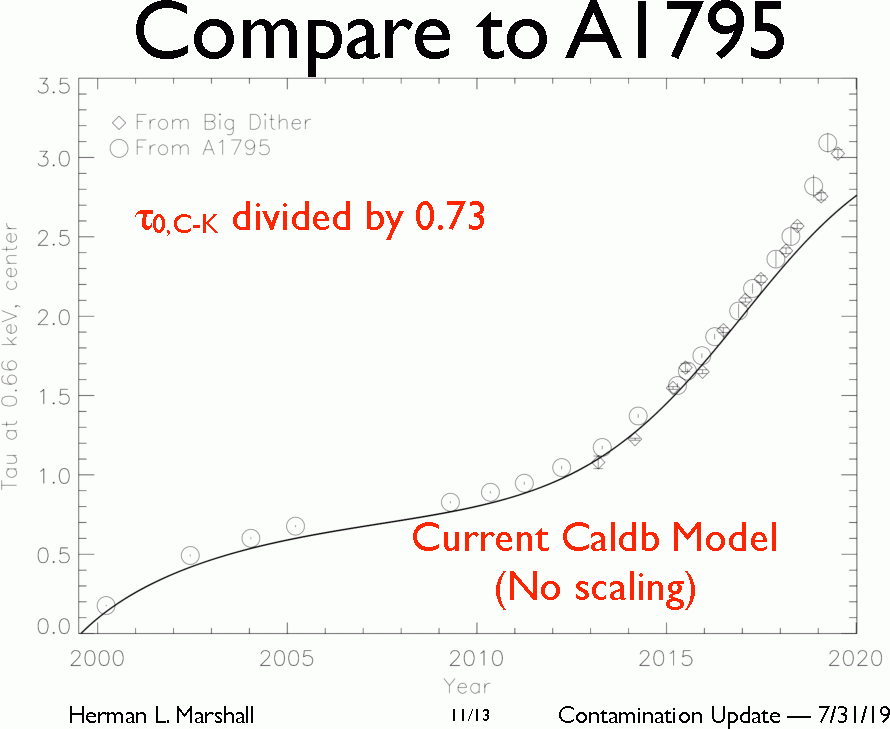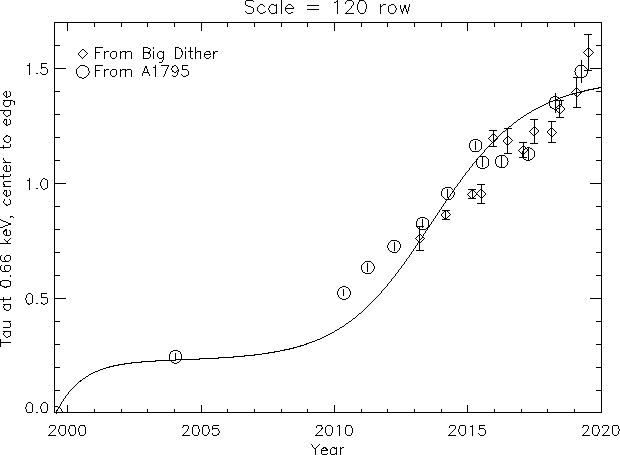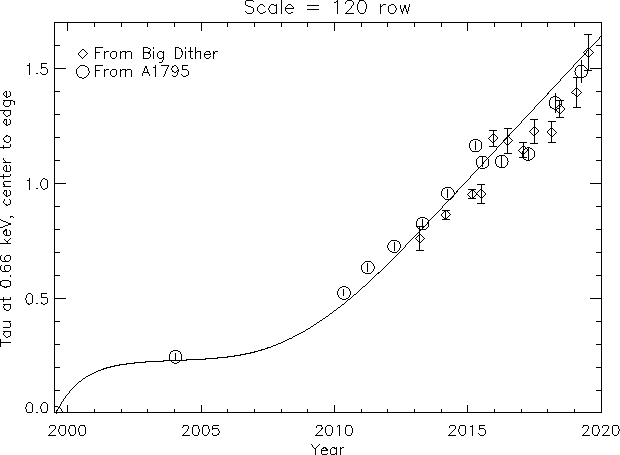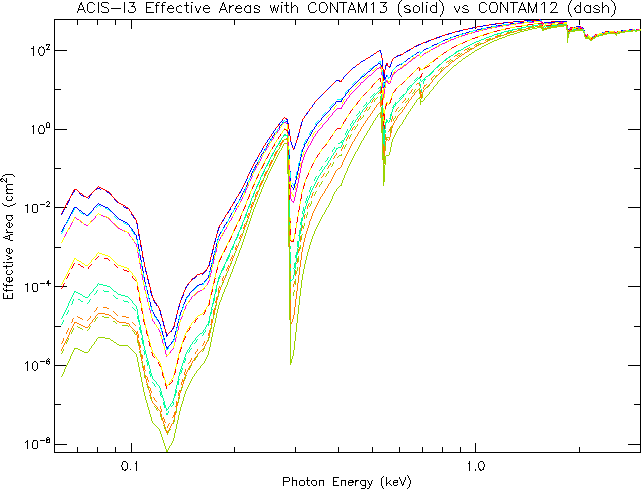CalDB 4.8.5 Public Release Notes
Public Release Date: 07 Nov 2019
I. INTRODUCTION
CalDB 4.8.5 is an upgrade to the Chandra CalDB, which includes the following items:
For the CIAO 4.11 / CalDB 4.8.5 release notes see How CalDB 4.8.5 Affects Your Analysis.
II. SUMMARY OF CHANGES
A. ACIS CONTAM Version N0013
| Location: | $CALDB/data/chandra/acis/contam/ |
| Filename: | acisD1999-08-13contamN0013.fits |
Analysis of recent observations of previously-observed cosmic sources, such as certain clusters of galaxies and supernova remnants, have resulted in unexpected increased temperatures and reduced flux levels that have been traced to a deviation of the ACIS contaminant model (CONTAM in CalDB) from calibration measurements. As illustrated in Fig. 1 below, the solid trace which represents the current (version N0012) contamination model in CalDB is no longer representative of the most recent data points from Abell 1795 or Mkn 421 ("big dither") observations. It seems that the contaminant deposition with time has not leveled off, as suggested in previous measurements, but has resumed its inexorable quasi-linear climb. Hence it is time to update this model to improve its performance since about 2018 for center-array optical depths and for center-to-edge spatial modeling since about 2015. Indeed, the new model specifies a linear layer depth with time since 2016, as well as a linear center-to-edge dependence with time since around 2010-2011.

Fig. 1: The current contamination model (version N0012), normalized for comparison with optical depth Tau derived at 0.66 keV from
Abell 1795 and Mkn 421 "big dither" LETG/ACIS-S observations. While the model is anticipating the contaminant deposition leveling off
with time beyone 2016, the actual contamination appears to be increasing linearly with time since 2015.
The current and new models are compared with calibration data in the technical details section below.
See the why page for more general information on the ACIS OBF contaminant.
CIAO SCRIPTS/TOOLS AFFECTED:
See the script fluximage, which uses mkinstmap
See the script specextract, which uses mkwarf
See the script fullgarf, which uses mkgarf
THREADS AFFECTED:
For exposure-corrected imaging analysis with ACIS, see the threads:
- Single Chip ACIS Exposure Map and Exposure-corrected Image
- Multiple Chip ACIS Exposure Map and Exposure-corrected Image
For imaging spectroscopy with ACIS, see the threads:
- Extract Spectrum and Response Files for a Pointlike Source
- Extract Spectrum and Response Files for an Extended Source
- Extract Spectrum and Response Files for Multiple Sources
For grating spectroscopy with ACIS, see the threads:
III. TECHNICAL DETAILS
A. ACIS CONTAM Version N0013
To illustrate the change that the new ACIS CONTAM N0013 model introduces, including the full mission timeline, we present the old model in Figs 2a (optical depth Tau at the center) and 2b (Tau from center to edge) against calibration data versus time derived from A1795 and Mkn 421 observations. For comparison, the new model is presented against the same calibration data in Figs 3a and 3b. Clearly the new model gives a much better representation of the contaminant layer depths in the recent two years.
Having clarified the reason for updating the ACIS CONTAM model above, we now can illustrate how it changes the ACIS-I (Figs 4a & b) and ACIS-S (Figs 5a & b) aimpoint ARFs, respectively, with a sample of mission timeline dates. We have chosen mid-cycle dates (May 15) from years 2000, 2005, 2010, 2015, 2017, 2019, and predictively for 2022. For ACIS-I, there are some more significant low-energy changes for ealier dates versus the previous model, but these will be ineffectual because the ACIS-I EA is so small at these energies in any case. For ACIS-S, there is very little variation between the old and new models at early mission times, and a significant improvement in the model behavior (with respect to the actual contaminant build-up) in more recent years.







